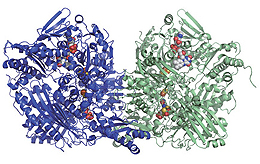Research Abstract
哺乳類とバクテリアのキサンチン酸化還元酵素に対してフェブキソスタットが示す異なる阻害効果 - 分子動力学からの視点
Different inhibitory potency of febuxostat towards mammalian and bacterial xanthine oxidoreductases: insight from molecular dynamics
2012年3月23日 Scientific Reports 2 : 331 doi: 10.1038/srep00331

最近、アメリカ合衆国、ヨーロッパ連合および日本で承認された痛風の治療薬であるフェブキソスタット(febuxostat)は、プリン分解の過程においてキサンチン酸化還元酵素(XOR)による尿酸の産生反応を阻害する。フェブキソスタットはピコモル濃度オーダーのKiで牛乳由来のXORを阻害するが、光合成細菌(Rhodobacter capsulatus)由来のXORに対する阻害剤としては、ずっと弱いことが判明した。しかし、哺乳類と細菌のXORの基質が結合するポケットについては、触媒能に重要な残基や三次元構造に関してよく保存されており、コンピューターによるドッキング解析によれば、この阻害剤はどちらの酵素の活性部位にもはまり込むことができる。このような2つのXORに対する阻害効果の違いの理由を明らかにするために、我々は分子動力学的シミュレーションを行った。その結果、基質と直接相互作用しない疎水性残基の可動性の違いが、阻害効果の違いを生み出していることが明らかになった。
- 日本医科大学医学部 物理学教室
- 東京工業大学大学院 生命理工学研究科
- 理化学研究所 次世代計算科学研究開発プログラム
- 日本医科大学 生化学分子生物学講座
- ポツダム大学 生化学(ドイツ)
- カリフォルニア大学リバーサイド校生化学(米国)
- 東京大学大学院 農学生命科学研究科
Febuxostat, a drug recently approved in the US, European Union and Japan for treatment of gout, inhibits xanthine oxidoreductase (XOR)-mediated generation of uric acid during purine catabolism. It inhibits bovine milk XOR with a Ki in the picomolar-order, but we found that it is a much weaker inhibitor of Rhodobacter capsulatus XOR, even though the substrate-binding pockets of mammalian and bacterial XOR are well-conserved as regards to catalytically important residues and three-dimensional structure, and both permit the inhibitor to be accommodated in the active site, as indicated by computational docking studies. To clarify the reason for the difference of inhibitory potency towards the two XORs, we performed molecular dynamics simulations. The results indicate that differences in mobility of hydrophobic residues that do not directly interact with the substrate account for the difference in inhibitory potency.

